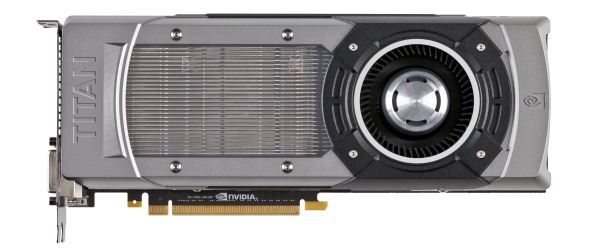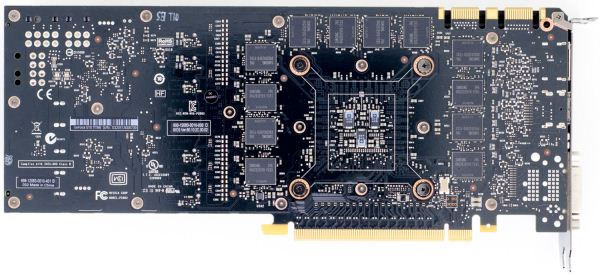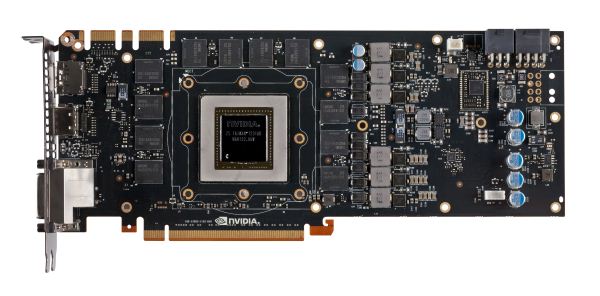NVIDIA's GeForce GTX Titan, Part 1: Titan For Gaming, Titan For Compute
by Ryan Smith on February 19, 2013 9:01 AM ESTMeet The GeForce GTX Titan
As we briefly mentioned at the beginning of this article, the GeForce GTX Titan takes a large number of cues from the GTX 690. Chief among these is that it’s a luxury card, and as such is built to similar standards as the GTX 690. Consequently, like the GTX 690, Titan is essentially in a league of its own when it comes to build quality.
Much like the GTX 690 was to the GTX 590, Titan is an evolution of the cooler found on the GTX 580. This means we’re looking at a card roughly 10.5” in length using a double-wide cooler. The basis of Titan’s cooler is a radial fan (blower) sitting towards the back of the card, with the GPU, RAM, and most of the power regulation circuitry in front of the fan. As a result the bulk of the hot air generated by Titan is blown forwards and out of the card. However it’s worth noting that unlike most other blowers technically the back side isn’t sealed, and while there is relatively little circuitry behind the fan, it would be incorrect to state that the card is fully exhausting. With that said, leaving the back side of the card open seems to be more about noise and aesthetics than it does heat management.
Like the GTX 580 but unlike the GTX 680, heat transfer is provided by a nickel tipped aluminum heatsink attached to the GPU via a vapor chamber. We typically only see vapor chambers on premium cards due to their greater costs, but also when space is at a premium. Meanwhile NVIDIA seems to be pushing the limits of heatsink size here, with the fins on Titan’s heatsink actually running beyond the base of the vapor chamber. Meanwhile providing the thermal interface between the GPU itself and the vapor chamber is a silk screened application of a high-end Shin-Etsu thermal compound; NVIDIA claims this compound offers over twice the performance of GTX 680’s grease, although of all of NVIDIA’s claims this is the least possible to validate.
Moving on, catching what the vapor chamber doesn’t cover is an aluminum baseplate that runs along the card, not only providing structural rigidity but also providing cooling for the VRMs and for the RAM on the front side of the card. Baseplates aren’t anything new for NVIDIA, but again this is something that we don’t see a lot of except on their more premium cards.
Capping off Titan we have its most visible luxury aspects. Like the GTX 690 before it, NVIDIA has replaced virtually every bit of plastic with metal for aesthetic/perceptual purposes. This time the entire shroud and fan housing is composed of casted aluminum, which NVIDIA tells us is easier to cast than the previous mix of aluminum and magnesium that the GTX 690 used. Meanwhile the polycarbonate window makes its return allowing you to see Titan’s heatsink solely for the sake of it.
As for the back side of the card, keeping with most of NVIDIA’s cards Titan runs with a bare back. The GDDR5 RAM chips don’t require any kind of additional cooling, and a metal backplate while making for a great feeling card, occupies precious space that would otherwise impede cooling in tight spaces.
Moving on, let’s talk about the electrical details of Titan’s design. Whereas GTX 680 was a 4+2 power phase design – 4 power phases for the GPU and 2 for the VRAM – Titan improves on this by moving to a 6+2 power phase design. I suspect the most hardcore of overclockers will be disappointed with Titan only having 6 phases for the GPU, but for most overclocking purposes this would seem to be enough.
Meanwhile for RAM it should come as no particular surprise that NVIDIA is once more using 6GHz RAM here. Specifically, NVIDIA is using 24 6GHz Samsung 2Gb modules here, totaling up to the 6GB of RAM we see on the card. 12 modules are on front with the other 12 modules on the rear. The overclocking headroom on 6GHz RAM seems to vary from chip to chip, so while Titan should have some memory overclocking headroom it’s hard to say just what the combination of luck and the wider 384bit memory bus will do.
Providing power for all of this is a pair of PCIe power sockets, a 6pin and an 8pin, for a combined total of 300W of capacity. With Titan only having a TDP of 250W in the first place, this leaves quite a bit of headroom before ever needing to run outside of the PCIe specification.
At the other end of Titan we can see that NVIDIA has once again gone back to their “standard” port configuration for the GeForce 600 series: two DL-DVI ports, one HDMI port, and one full-size DisplayPort. Like the rest of the 600 family, Titan can drive up to four displays so this configuration is a good match. Though I would still like to see two mini-DisplayPorts in the place of the full size DisplayPort, in order to tap the greater functionality DisplayPort offers though its port conversion mechanisms.














157 Comments
View All Comments
TheJian - Wednesday, February 20, 2013 - link
http://www.guru3d.com/articles-pages/geforce_gtx_t...1176mhz from 876 (boost). No bad for $2500 K20 basically for $1000. I've never done homework on it, but I don't think K20's overclock, but I could be wrong.
Can't wait to see the review tomorrow. Clearly he'll bench it there and he has 3 :) You should get your answers then :)
I'm wondering if some hacker will enable the K20 drivers, or if that's possible. It seems a lot of reviewers got 3, so you should have lots of data by weekend.
Bill Brasky - Tuesday, February 19, 2013 - link
There were rumors this card would launch at 799-899, which made more sense. But for a grand this thing better be pretty darn close to 690.wand3r3r - Tuesday, February 19, 2013 - link
The price tag just makes this card a failure. It's a 580 replacement no matter how they label it, so they can shove it. They lost a potential customer...karasaj - Tuesday, February 19, 2013 - link
So what is the 680?Sandcat - Tuesday, February 19, 2013 - link
A GK104, which replaced the GF104,The GK110 is the replacement for the GF110, which was the GTX 580.
Ananke - Tuesday, February 19, 2013 - link
the 680 was meant as a 560ti replacement...however, NVidia decided it turns too good to be sold too cheap, and changed the model numbering...I have several close friends in the marketing at NV :)However, NV is using this GK110 core for HPComputing for the very beginning in the Quadro cards, since there they really cannot skip on the double precision.
CeriseCogburn - Sunday, February 24, 2013 - link
BS.The 680 core is entirely different, the rollout time is over half a year off, and that just doesn't happen on a whim in Jan2012 with the post mental breakdown purported 7970 epic failure by amd...
So after the scat lickers spew the 7970 amd failure, they claim it's the best card ever, even now.
R O F L
Have it both ways rumor mongering retreads. No one will notice... ( certainly none of you do).
rolodomo - Tuesday, February 19, 2013 - link
Their business model has become separating money from the wallets of well-to-do who have no sense of value and technology (NVIDIA's PR admits this in the article ). It is a business model, but boutique. Doesn't do much for the their name brand in the view of the technorati either (NVIDIA: We Market to Suckers).Wreckage - Tuesday, February 19, 2013 - link
It's almost as fast as a pair of 7970's that cost $1100 at launch.AMD set the bar on high prices. Now that they are out of the GPU race, don't expect much to change.
At least NVIDIA was able to bring a major performance increase this year. While AMD has become the new Matrox.
Stuka87 - Tuesday, February 19, 2013 - link
AMD is out of the GPU race? What are you smoking? A $1000 dollar card does not put AMD out of the GPU race. The 7970GE competes well with the 680 for less money (They go back and forth depending on the game).Now if this card was priced at $500 then that would hurt AMD as the prices on the 660/670/680 would all drop. But its not the case, so your point is moot. Not to mention this card was due out a year ago, and it got delayed. Which is why the GK104 was bumped up to the 680 slot.